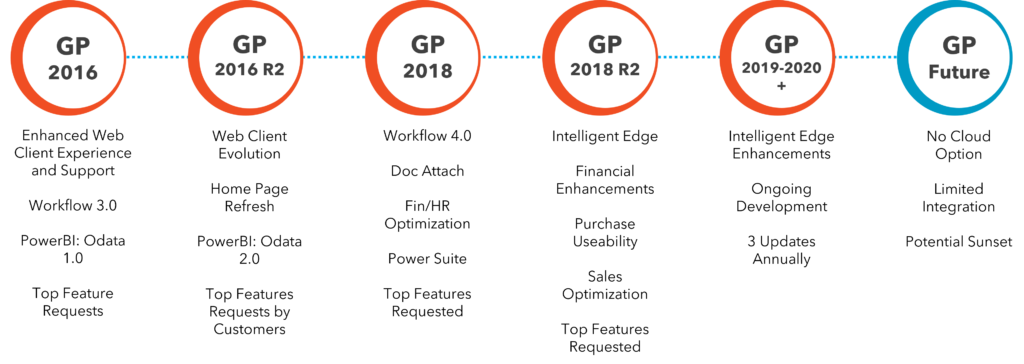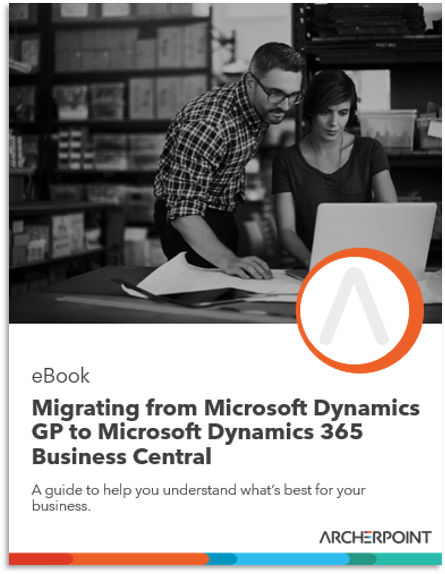10 Things to Consider When Migrating from Microsoft Dynamics GP to Business Central

If you’re using Microsoft Dynamics GP (Great Plains), you’re very aware of the product roadmap and software lifecycle policy. Like many GP users, you’ve probably been very happy with the product because it has been a workhorse for more than 30 years.
Microsoft has committed to supporting GP with bug fixes, security enhancements, and some limited new features for the foreseeable future. However, they will no longer be offering significant advances in the technology or capabilities, and there will never be a true cloud version of the product.
That’s why it’s important now—even if you’re not quite ready—to start planning for a move to Business Central. If this feels overwhelming, confusing, or frustrating, you’re not alone.
By creating a plan that addresses the following considerations, you will be well on your way to a clear strategy for selecting and changing to a new ERP (Enterprise Resource Planning) system.
1. Know the Direction of Dynamics GP
Before you can determine whether GP should remain in your future, you need to understand what GP’s future looks like. With that knowledge, you can assess your company’s current and future state and compare them with where GP is now and where it’s going:
- GP is currently supported, and it will continue to work for you just like it always has for the immediate future.
- Microsoft has committed to releasing three updates per year through 2024 and possibly beyond that date. These releases will consist of ongoing development, Intelligent Edge enhancements, and the top features requested by the GP community.
- Dynamics GP will follow Microsoft’s Modern Lifecycle Support Policy. Users will receive continuous support, including new features and enhancements, if they install at least one of the three GP updates every year.
- You can host GP on premises or in the cloud, hosted by a hosting provider.
- GP is not a true cloud product, and Microsoft has made it clear that there are no plans to make it one. While you can have it hosted, it is still limited by what it can do in terms of integrating with external applications and leveraging the cloud’s capabilities.
- GP is not architected to integrate fully with other modern business technology and tools.

Figure 1 – Microsoft Dynamics GP Roadmap
What does all this mean?
First, it means you do not have to change solutions today. You can continue using GP until you are ready to make a move—with the understanding that processes that could be otherwise eliminated will need to remain as is until you move to Business Central. It also means that you will not see many exciting new features. Microsoft has focused much of their development on Microsoft Dynamics 365 Business Central as their core cloud product for the mid-market. To access all the innovative technology and features Microsoft is rolling out, you will need to move from GP to Business Central.
Get your checklist and discover if now is the right time to make a move
2. Analyze Your Company’s Current State
Now that you understand the current state and roadmap of GP, it’s time to look inward. When was the last time you purchased an ERP? Five years ago? Ten? Twenty? You probably had a requirements checklist of features (GL, AP, AR, inventory, warehouse, etc.). That was the way ERP systems were evaluated and selected back then.
Not only has technology changed, but the needs of businesses and the approach to selecting software has changed. The features you needed in an ERP back when you first bought GP are now standard in most solutions today. As a result, the focus is not on features anymore; today, it’s more about the integration of your ERP with other aspects of your business. Investing in a solution that accommodates the way you do business now and has the flexibility to change as your needs change is important to keeping pace with growth and a competitive landscape that is constantly in flux.
The first step is to conduct an analysis of your current state.
BEFORE YOU BEGIN: It is especially important NOT to assume anything at this point. Don’t assume that a particular process is working well; it could be that the process has been adjusted over time to fit outdated software. We’ve seen many business fall into this trap. Once they work with a consultant to perform a business process analysis, they can see where their systems are serving them and where their processes need adjustments.
Steps for analyzing your business processes
- Document current processes related to Dynamics GP, including what is working well and what is not working.
- Interview the people who are using Dynamics GP. Ask specific questions about what they like and don’t like, what takes a long time, extra steps, or causes them to augment their processes due to system constraints. Also ask what they would like to be able to accomplish that they cannot accomplish now due to process or system issues.
- Look at other indicators, like customer feedback. Often, issues with customer service or delivery times, for example, will expose problems that your ERP is contributing to or could help remedy.
There are many more methods you can employ, but the overall goal is to have a full understanding of how your business is operating right now and how GP is supporting that operation. It’s our guess that you will be shocked at how many processes have been adjusted to fit GP—processes that could be streamlined, automated, or even eliminated.
3. Know Your Company Roadmap and Goals
Now that you know where you are, the next step is to know where you are going. Do you have a company roadmap that outlines the milestones and goals you want to achieve over the next 3 to 5 years and beyond? To make an intelligent ERP purchase—an investment that companies commit to for an average of 5-10 years—you need to have a full understanding of what your company plans to achieve in that time period.
The goal here is to determine whether GP can accommodate these milestones and goals. If one of your goals is to increase mobility of your workforce, for example, GP may become a hinderance because it is not designed to be a cloud-based product.
4. Consider the Cloud
Microsoft has invested significantly in the cloud and the fact that they will not be creating a true-cloud version of Dynamics GP is telling. A true cloud application is one that runs independent of hardware and can be accessed using only a web browser. True cloud-based software (also known as Software as a Service, or SaaS) has several distinct advantages over the typical client-server, on-premises model used by GP.
In 2018, Forbes reported 83% of enterprise workloads will be in the cloud by 2020, and ERP has been keeping the same pace. In just the last five years, key players like Oracle and Sage paid hefty premiums to purchase cloud-based ERP products (NetSuite and Intacct, respectively).
Some of the advantages of cloud ERPs include:
- Security. SaaS applications offer an edge in security versus running the same software on-premises. In fact, a recent report by cybersecurity experts at Coalfire showed that major cloud services providers are only about half as likely (46%) to experience a data breach compared with large enterprises. For example, Microsoft’s Azure hosting environment offers state of the art security software, intrusion detection, geographically distributed servers, and backup and failover capabilities that are typically beyond the resources of the standard small and mid-sized company. Very few data breaches have been successful attacking major cloud hosting providers like Microsoft Azure or Amazon Web Services (AWS). And automatic data backups help to insulate your company from the threat of ransomware and other malicious cyberattacks.
- 24/7 access from anywhere, on any device. Cloud-based applications can be accessed using any browser-enabled device, from anywhere an internet connection is available at any time of the day or night. And most modern cloud applications will dynamically reconfigure the display of information to match the screen size and dimensions of the device used to access them (known as responsive design).
- Lower IT costs. Using a SaaS ERP across the company means you no longer need to buy, maintain, or upgrade servers for your ERP ever again. This reduces the strain on company resources and your IT department, freeing up those budget dollars and personnel for more high-value work.
- Scalability. SaaS ERP systems can be quickly resized as your business needs change. Server size, storage and memory capacity, users, and sandbox environments can be increased or decreased as needed, and you only pay for what you need, when you need it.
- Easier upgrades. Most modern SaaS applications allow users to elect to have software updates to take place automatically, so your team never has to face the daunting task of massive upgrades for your software. Each organization is different, and add-ons from ISVs will influence considerations for your upgrades, but this is a positive step in the world of upgrading.
These are just a few of the many advantages of moving to a SaaS ERP application and should weigh on your decision of when to migrate from GP to Business Central.
5. The Advantages of Staying with Microsoft
The advantages of staying with Microsoft are many, including the opportunity to leverage the capabilities of the Microsoft Azure and Power Platforms, pricing incentives for existing Dynamics customers, and the technology supported and offered by the Microsoft technology stack, including artificial intelligence and machine learning. However, the most compelling reason to stay with Microsoft is the benefits of Business Central’s full integration with other Microsoft products like the productivity suite (Outlook, Word, Excel, etc.), Teams, and SharePoint. Your team is proficient and comfortable with these tools, resulting in simplified user adoption, ease of use, and reduced training time of Business Central. On the back end, Azure and the Power Platform offer the flexibility to address any business need, no matter how specific or unique.
Another benefit of staying with Microsoft is that they have created tools to allow the migration of your Dynamics GP data and transaction history to the latest version of Dynamics Business Central Online (SaaS). This simplifies the process of changing systems.
6. Dynamics 365 Business Central—Consider Your Closest Option
Having discussed the advantages of a cloud-based ERP over traditional, client-server ERPs, there are several modern, mid-market ERPs that are potential replacements for GP, including Oracle NetSuite, Sage Intacct, Acumatica, and Microsoft Dynamics 365 Business Central. While each of these products have distinct advantages and disadvantages, the advantages of staying in the Microsoft family go unmatched by other technology providers.
Business Central is particularly well suited for mid-sized manufacturers, distributors, retailers, and professional services companies. Some of these advantages include:
- Flexible and easy to customize. Business Central has a visual drag-and-drop interface that allows users with no development experience to customize the software with no-code/low-code options to match the way they do business. For more sophisticated customizations, Business Central’s logic can be easily modified to perform more complex functions. All these customizations are preserved between software updates.
- Can run on premises or in the cloud. Running Business Central does not require users to run their software in the cloud. Business Central can also be deployed on premises for business or regulatory reasons. Users can always move Business Central to the cloud if and when they are ready.
- Supported by a large developer community. Business Central is supported by nearly 1,000 specialized applications that extend its capabilities, developed by Independent Software Vendors (ISVs). Apps cover nearly any need from credit card payments to warehouse management and beyond. See the ISV products available for Business Central by visiting Microsoft’s AppSource.
- Easily integrates to external applications. Business Central comes with native integrations to popular third-party cloud applications. If you don’t find an integration to an application you are using, one can be built using Business Central’s development environment. This lets Business Central integrate to HCM, CRM, Payroll, and many other modern business applications.
- Includes better manufacturing and distribution capabilities than GP. Business Central comes with native, real-time manufacturing and distribution capabilities and can be easily extended to perform complex functions, including production orders, bills of materials, warehouse and inventory management, supply chain management, lot and serial tracking, bar coding, and more.
- Provides better support for branches and multiple entities than GP. Business Central comes with more robust capabilities to handle multiple branches and entities within the organization.
- Has features not found in GP. Business Central comes with integrated features such as Microsoft (Office) 365 integration, dimensions, built-in CRM, and extensive financial reporting options.
- Offers out-of-the-box dashboards. Business Central allows users to customize their own dashboards, so they can follow the key data that affects their work the most. Preconfigured dashboards are available out-of-the-box, or they can be modified or created on the fly as needed with no coding required.
- Easy to add user-defined fields to records and reports. Data in Business Central is easily accessed for use in dashboards and reports. Customize reports, add fields to customer records, show fields in dashboards – all with little or no coding required.
- Leverages the capabilities of the Microsoft Power Platform. The Power Platform is a suite of applications that makes access to information easy, particularly for the non-technical end user. Use the Power Platform to connect Business Central to other applications, such as Microsoft (Office) 365, Azure services, and many third-party applications. Components of the Power Platform include:
- Power BI – Gather meaningful business intelligence in real time by collecting data from Business Central and other business applications and using this information for proactive insights and decision making.
- Power Apps – Non-technical users can use low-code/no-code and point-and-click features to create powerful custom applications quickly.
- Power Automate (formerly Flow) – Create workflows to automate repetitive tasks and processes for your business.
- Power Virtual Agents – Build chatbots to engage with customers with no coding required.
- AI/ML – Use Artificial Intelligence and Machine Learning with Power Apps and Power Automate, using features like phrase, text, and image extraction and recognition, language detection, and category classification to automate workflows, customize applications, and leverage features in Microsoft 365 applications.
Microsoft has the power to offer a ton of value in a competitively priced, cloud-based ERP system with Business Central.
7. Understand All Your Options
Consider all your options, whether it’s for the short-term or part of a larger, strategic decision. Here are a few options to consider.
Weigh all your options when moving from GP to Business Central
Option #1: Do nothing
As discussed earlier, true-cloud ERPs offer many advantages over remaining on GP, such as better security, 24/7 access from anywhere using any device, lower IT costs, and simplified upgrades. Likewise, Microsoft Dynamics 365 Business Central has distinct advantages over most other true-cloud ERPs, including more deployment options, more manufacturing and distribution capabilities, and out-of-the-box dashboards. For these reasons, most GP users will want to migrate to a modern, cloud-based ERP—and Business Central should be on the short list.
However, some users might consider the hassle and the cost of migrating to a new ERP to be too much of a burden. If you decide to remain on GP indefinitely, you need to consider the long-term impact:
- Doing nothing will still cost you money. You will have to continue paying for support to remain current on GP releases to receive updates and support from Microsoft. Updates will include some new capabilities, bug fixes, and security features which are critical for business continuity. Security updates are important – and you don’t get them unless you are current on maintenance.
- You will not be able to take advantage of the automation and productivity features of Business Central. There is a cost associated with the lost productivity of not moving to a modern, cloud-based ERP application like Business Central.
- You will still be required to upgrade and maintain your hardware. While you will not have to migrate your software, you will still be required to maintain your servers to run GP on premises. And maintaining on-premises equipment means upgrading operating systems, purchasing new hardware, performing backup and restore procedures, and exposure to network security risks and cyberattacks.
- Over time, there will be fewer and fewer GP specialists. There is reasonable doubt in the GP support community that Microsoft intends to support GP indefinitely. The result is that as the current pool of administrators, consultants, and developers age, there will be a reluctance of younger talent to replace them. These individuals will prefer to invest their time and talent in products they see as having a longer time horizon. Whether or not Microsoft continues to support GP, it’s foreseeable that qualified talent will be harder to find.
Option #2: Host GP In the cloud
Another option is to have your GP solution hosted in the cloud by a partner. This can be an attractive option for the following reasons:
- It eliminates hardware costs. The hosting provider will maintain your hardware for you, saving you the upfront cost of hardware and the continuing cost of maintenance and upgrades.
- You can better manage your ERP cash flow. Hosted GP is available by subscription, giving you a predictable monthly cost that you can manage.
- You get more scalability. You can quickly scale your solution up or down as your business needs change—even temporarily—so you pay only for what you need and get the resources you need when demand is high.
One downside is that, even though hosting GP allows users to access the application via the web, GP itself is not a true SaaS product and therefore does not offer the benefits of an application that was built for the cloud, like Dynamics 365 Business Central. And, as times passes, there will be a greater risk of issues around the product simply not being designed for the cloud. However, if your goal is to get 24/7 access through a web browser or to offload hardware, maintenance, or demands on your IT staff, this is a viable option, at least for the short term.
Option #3: Migrate to Business Central
The next option is to make the move to Business Central. As we mentioned earlier, there are certainly other cloud ERPs, but for most companies using GP, Business Central offers you the biggest bang for the buck. Moving to Business Central from GP is not as daunting as it might seem. And once the migration is complete, your company will reap all the benefits of Business Central:
- Integration with all the modern Microsoft applications that your team uses like Microsoft (Office) 365
- Flexible and easy to customize
- Run on premises or in the cloud
- Support from a large developer community
- Easier integration with external applications
- Better support for branches and multiple entities
- Out-of-the-box dashboards included
- Allows adding user-defined fields to records and reports with ease
- Leverages the capabilities of the Microsoft Power Platform
Moving to Business Central SaaS is simplified by the migration toolkit provided by Microsoft. It brings your master data and historical transactions into Business Central.
Option #4: Utilize Microsoft’s Edge Services
GP users who would like to access the benefits of the Microsoft Power Platform (Machine Learning, Power BI, Power Apps, Power Automate), but who aren’t ready to move off GP yet, can connect to Business Central using Microsoft’s Intelligent Edge service. This configuration uses data from your GP system and uploads it to an instance of Business Central in the cloud. Business Central can then interact with Microsoft cloud services, letting you take advantage of Business Central without having to leave GP.
The Choice Is Yours
Microsoft advises all on-premises and legacy Dynamics NAV, GP, and SL clients to migrate to Business Central Online. As Microsoft states in the Application and System Features Guide for Microsoft Dynamics GP 2018 R2:
“While Microsoft continues to support their NAV, GP, and SL deployments, these customers can choose when they want to transition to Dynamics 365 Business Central, as a perfect match for their businesses. Dynamics GP and Dynamics SL will continue to receive product improvements and updates, but the most benefit to these customers comes from upgrading to Dynamics 365 Business Central.”
8. Don’t Make the Decision in A Vacuum: Discuss It with a Microsoft Dynamics 365 Business Central Expert
We cannot stress enough the importance of finding a qualified, experienced partner to work with you on your plan—and the sooner you find one, the better. Microsoft Dynamics partners are accustomed to talking with customers months out from an ERP selection because it is an important and expensive decision. Even if you’re not ready to buy yet, a good partner can help you get a handle on everything discussed in this blog—from guiding you in the assessment of your current state to helping you with building your criteria for a new ERP to talking with you about things like your infrastructure.
9. Create A Plan, Budget, And Timeline
It should be clear by now that, for most GP users, moving from GP to Business Central is a question of when, not if. While you do have options for the short term, the most realistic approach is to expect that you will need to change ERPs within the next few years—and now is the time to plan, budget, and start researching a viable product and partner who can help you. Here are some tips.
Get a no obligation assessment with an ArcherPoint Business Central Expert
Determine a timeline
Look at your company’s roadmap, short-term and long-term goals, key initiatives, and resources to determine when you’re likely to make the switch. If it’s six months from now, you’ll need an aggressive timeline. If you’re thinking about two years from now, you can then schedule your evaluations, determine resources, and begin to make budget plans for the targeted start date.
Evaluate products and partners
There will be time required to perform your due diligence in evaluating and reviewing solutions and selecting the right partner. Do not select one without the other—they each make up half of a complete solution. You will need to put together a project team to develop your requirements, view demonstrations, evaluate potential products, and develop a short list of candidates.
Build a high-level budget
Changing your ERP will be a new implementation, regardless of the solution you choose. Staying in the Microsoft family will simplify the migration, but you should be clear on the fees for software and services required for a successful go-live. Make sure you budget for it. Consider the need to review your business processes with a third-party firm or business analyst and determine the need for add-on products to meet your specific industry needs.
10. Take the First Step
The reality is there is no one-size-fits-all ERP solution. Each product has its own benefits and drawbacks. And let’s not kid ourselves, it won’t be as simple as converting your database. Anything other than a GP upgrade is a new ERP implementation. There will be implementation costs, customizations, and third-party software add-ons to anybody’s solution, regardless of which ERP you choose.
Get started today by scheduling a free one-hour assessment to determine if Dynamics 365 Business Central is the right choice for you.




